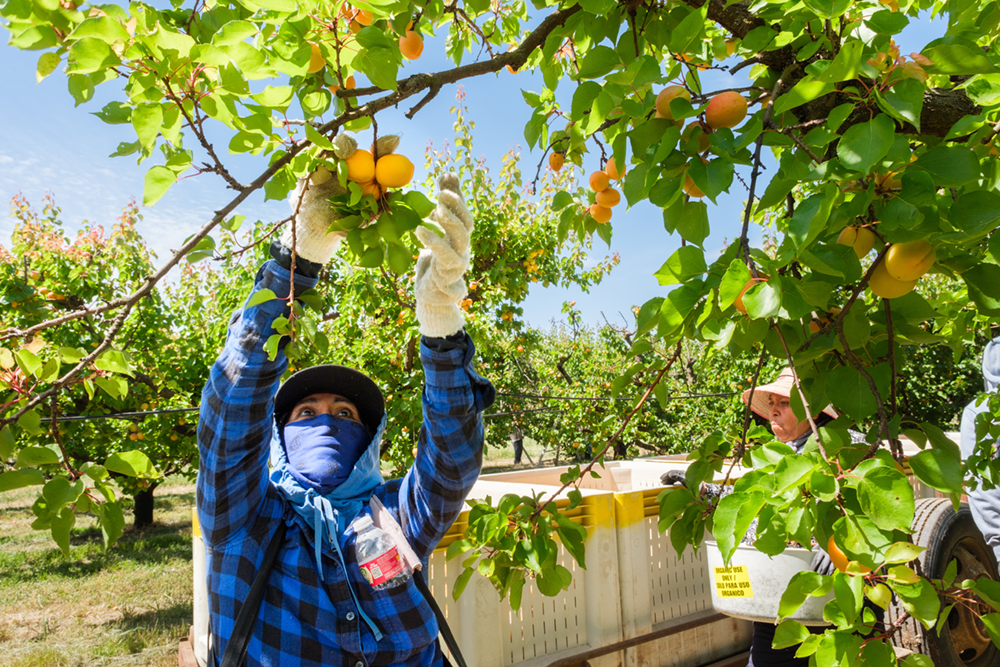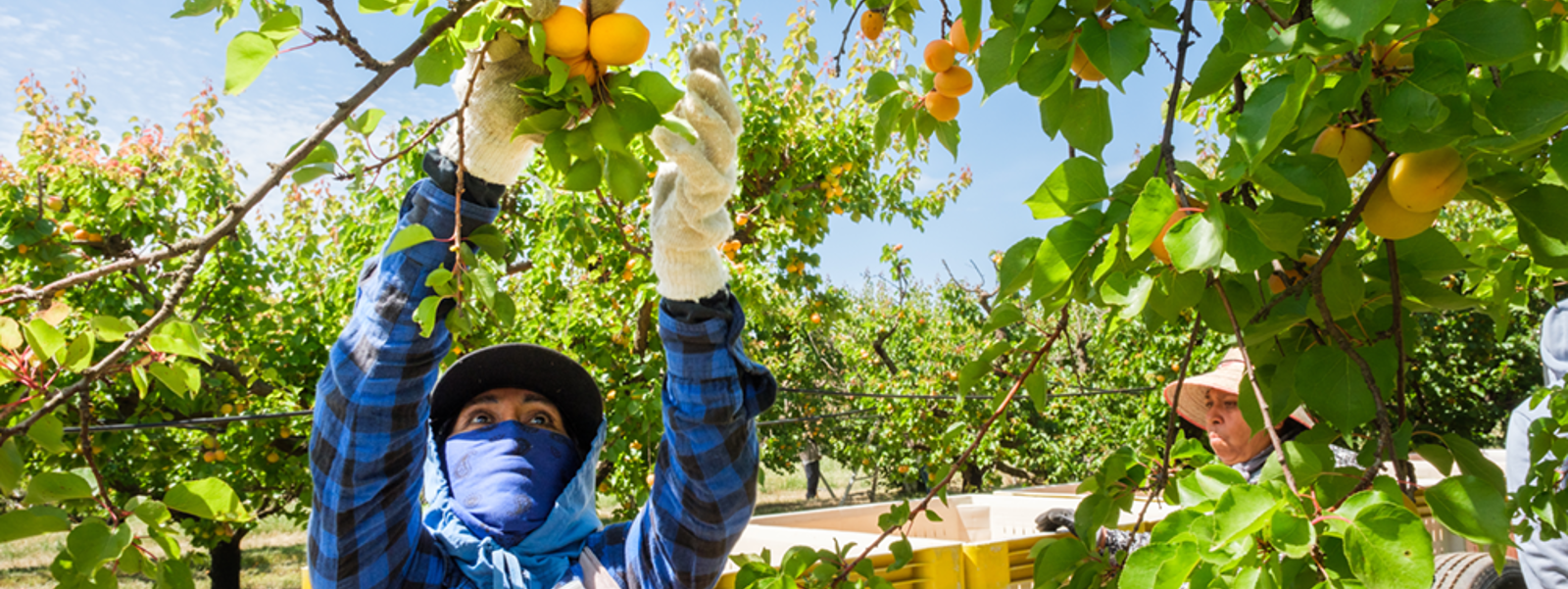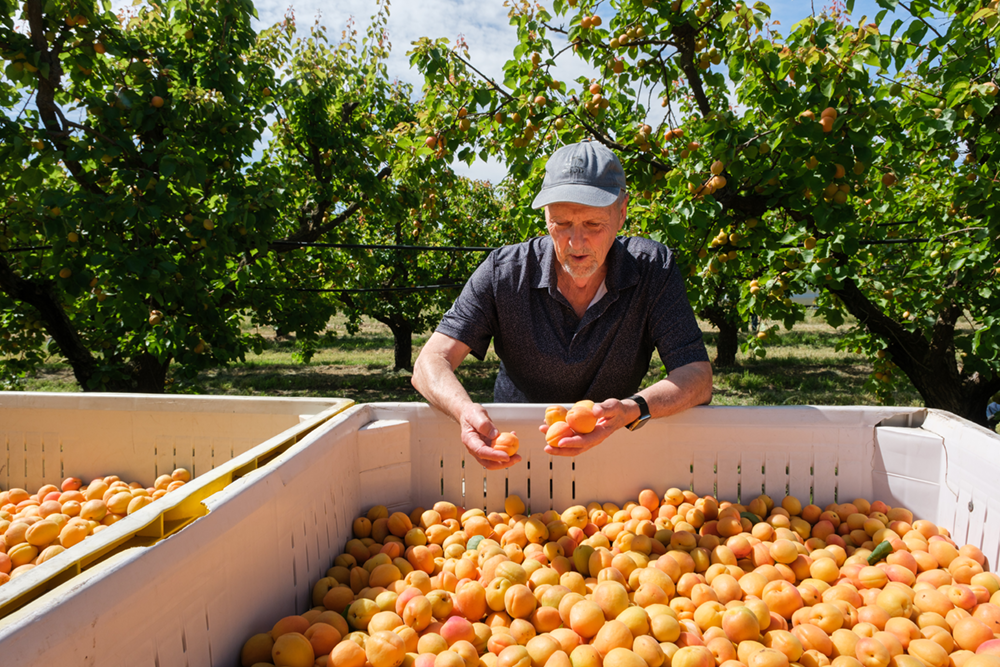Apricot growers work to rebuild markets

Leovigilda Velázquez picks apricots at Lucich Santos Farms in Stanislaus County. Some growers describe this year’s crop as slightly smaller than last year’s, when California harvested about 30,000 tons of the stone fruit. With processors and dry yards taking less fruit, more apricots are marketed fresh.
Photo/Steve German


Photo/Steve German
By Ching Lee
After years of removing trees, California’s remaining apricot growers say they have found a balance between supply and demand, allowing the crop to be profitable.
But the downward trend in production has reduced the sector to a fraction of what it once was, even though the Golden State remains the nation’s top producer of apricots. The state harvested 5,300 acres of apricots last year, down from more than 15,000 acres in 2003.
So many apricot orchards have vanished that even a slight increase in acreage could “bump you back up into an oversupply situation,” said Stanislaus County grower Daniel Bays, who serves as president of Apricot Producers of California. For this reason, growers wanting to get in the business or expand their existing apricot plantings may want to think twice.
“Our big challenge as an industry is to try and grow consumer demand before we go hog wild planting newer additional acres of apricots,” Bays said.
Not that many growers are rushing into apricots. The delicate fruit remains labor-intensive and costly to grow and pick, most of it still done by hand. For years, California growers—who produce 90% of the nation’s supply—have been losing markets to imports, especially dried apricots from Turkey. Falling consumption of canned fruit led to closures of canneries, which still buy a major portion of the crop.
Most of the state’s apricots have traditionally gone to processing—for canning, freezing, drying, juice, jams and other products. But fresh-market volume has grown. In 2021 and 2022, for example, the share of fresh-market apricots surpassed processed fruit, according to estimates from Apricot Producers of California, which negotiates prices for growers.
Despite gains in the fresh market and rising consumer interest in locally grown produce, Bays said the diminished processed market has made growing the sector more untenable. As it is, the U.S. Department of Agriculture already buys a significant share of the canned and frozen products for school lunches, food banks and other assistance programs to help keep inventories in balance.
“I don’t know that it’ll ever rebound back to what the industry was 40 or 50 years ago,” Bays said, though he added he sees some opportunities for growth. “A lot of that depends on our food system, consumers and how people are going to eat and what they’re going to eat.”
With the price of almonds and walnuts trending lower in recent years, Bays said there’s renewed interest in tree fruit, with farmers diversifying or increasing plantings of other types of permanent crops, including apricots and other stone fruit. The key is to have “smart, slow, sustainable growth,” he said.
Apricot acreage on his farm has stayed at about 400, making him one of the state’s largest growers. His family used to farm more than 1,500 acres in the early 1990s.
With less fruit going to processing, focus has been on the fresh market. But the apricot’s fragile nature and short shelf life have been its Achilles’ heel. When apricots are canned, dried or frozen, the fruit can be picked ripe with its high sugar and flavor preserved.
“It’s very difficult to get a ripe apricot to the store that’s got good flavor and still have it look visually appealing,” Bays said.
Dave Santos, co-owner of Lucich Santos Farms and Blossom Hill Packing in Patterson, said his farm continues to work with nurseries and plant breeders to test new varieties, noting some of the current ones on the market are much improved. When he started in the business in the early ‘70s, he said, “there was a joke that you could eat the apricot and chew on the box, and they would have about the same flavor.”
“Today, we’re working on fruit that tastes good, that matures well, has high brix and is something that the consumer will want to buy and come back and buy again,” he said.
His farm used to send 90% to 98% of its apricots to processing. As canneries disappeared, “we were some of the people that got left out, not having a home for our apricots,” Santos said. He and his partner started packing their own fruit, eventually building a small packing shed in 1978.
That business continues to grow, Santos said, these days packing 250,000 to 300,000 boxes of conventional apricots and some 100,000 boxes of organic apricots annually. The farm grows 14 varieties of apricots on about 700 acres, with 70% of the fruit going to the fresh market. The rest is shipped to Del Monte, Pacific Coast Producers and Del Mar Food Products for canning and freezing.
Smaller growers such as Jason Bremmer, who farms 6 acres of apricots in Colusa County, have managed to remain profitable by selling fresh apricots at peak ripeness—the way they’re meant to be eaten, he said. But that means having only three to five days to get rid of the fruit once it’s picked. He sells most of it at his farm stand, with the rest going to a local school district and two stores. Some of his farm stand customers come from as far away as Los Angeles, Oregon and Washington to load up on apricots, he said.
“We have people drive in and out of our place even when apricots aren’t ready because they want apricots,” Bremmer said. “People really like our apricots, and they continue to come every year.”
It wasn’t always this way. Before he took over the 20-acre farm more than 20 years ago, it used to be all apricots. The previous owner sold the crop to packers and juicers. But those markets have dwindled, he said. That’s why he turned 12 acres into almonds and switched to selling the apricots retail, which fetches a higher price.
Other longtime growers such as Stan Lester of Yolo County have gotten out of the business altogether. After he sold his bakery about a year ago, Lester removed his apricot orchard, as the bakery was a key outlet for the crop. He now leases the ground to a row-crop farmer.
“We used to cut and dry a lot of them and sell them at our bakery,” he said. “That used to be a big market of ours. We’d have people coming from all over trying our apricot pies.”
With minimum wage going up, he said the labor-intensive crop no longer made sense, let alone trying to find people willing to do the work or who have knowledge to do it. Even if harvest can be done by machine, which he said “doesn’t do a super great job,” the trees still must be pruned by hand every year.
Going forward, Stanislaus County grower Bays said he thinks the industry can do a better job marketing apricots to rebuild some of the processed market, such as by promoting the fruit’s health benefits. Producers have started a social media campaign with recipes and videos on how to use canned apricots, he noted. He pointed to the various products the almond sector has created to market the tree nut—from almond milk to almond butter to almond flour.
“Thirty years ago, no one thought about or used almonds in that way,” said Bays, an almond grower himself. “All it takes is being able to get the right kind of product or use for apricots.”
(Ching Lee is an assistant editor of Ag Alert. She may be contacted at clee@cfbf.com.)




